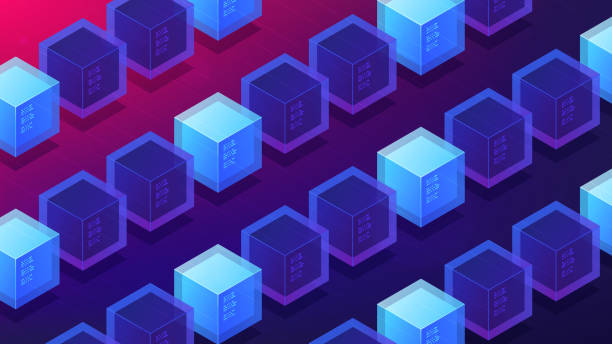
Big data. Information concept. 3D render
Supernets provide a high-speed, reliable and efficient network connection solution for businesses, government organizations and educational institutions. This guide is designed to help you understand the benefits of supernets and determine which projects may benefit from this technology.
Supernets use a combination of networks from multiple providers to provide seamless service. With improved reliability, faster connection rates, and the cost savings of using multiple suppliers, supernets provide more efficient communication pathways for large organizations with high-bandwidth needs. Supernets also improve performance by dynamically directing traffic across multiple paths to find the optimum route to increase speed and reduce latency.
This guide will discuss how supernets work, what types of projects can use them, and some potential drawbacks when utilizing this technology. Finally, we’ll wrap up this discussion by looking at two real world examples of how organizations have benefited from implementing supernet solutions that support large projects like streaming media or distributed applications.
What are Supernets?
Supernets are decentralized networks that use blockchain technology. These networks leverage multi-party collaboration and peer-to-peer activities to enable trustless interoperability between network participants. Supernets promote connectivity between digital assets and create an environment conducive to transferring value between parties. They also make it possible to securely store cryptographically signed transactions in a distributed ledger system.
A wide variety of projects can benefit from Supernets, ranging from financial services, digital asset trading, identity management, internet of things (IoT), data ownership and privacy management solutions, gaming industry solutions, medical communication solutions, among many others. For instance, projects such as Defi lending platforms, NFT markets, or stablecoins can use Supernets to facilitate seamless transactions with tokenized assets without sacrificing security or scalability.
In addition to applications for traditional businesses and institutions, Supernets can be used by anyone for any purpose within the scope of their usage rights or permissions given. As such, it provides users with a secure architecture optimized for transactional efficiency while still giving them the autonomy needed to build self-sustaining ecosystems on top of it. This makes Supernets a valuable infrastructure layer that can facilitate real-world utilization cases in countless industries while leveraging the blockchain’s core features: decentralization, immutability and verifiability of all data stored on-chain.

Benefits of Supernets
With the recent announcement that Polygon will invest $100M in projects that use its Supernets blockchain, many wonder what projects will benefit from such a powerful network.
Supernets provide a decentralized solution that can make transactions faster and more secure. In this article, we will look at the specific benefits of Supernets and discuss how projects can leverage this powerful network for their success.
Faster transactions
Supernets are sophisticated data networks built on a blockchain infrastructure. They provide a new way for businesses to scale quickly and securely. Supernets apply blockchain technology to speed up transaction processing, increase security, and lower business costs.
With Supernets, transactions are validated in seconds instead of minutes or days. This means that banks, retailers and other organizations can process payments quicker allowing them to realize large cost savings and dramatically improve customer satisfaction. Furthermore, as all transactions are recorded in an immutable public ledger, they can be verified more easily while also providing trust between transacting parties – eliminating the need for costly intermediaries and fees that would otherwise be incurred through traditional services providers SWIFT or ACH systems.
Businesses can reduce administrative time by using a single private key across different wallets on various blockchains because they no longer have to manage multiple keys on different blockchains due to their streamlined system providing one unified gateway. Furthermore customers benefit from fewer failed transactions and improved privacy & security due to decentralized identity management solutions leveraging personal data protection protocols & privacy enhancements for enterprise-level applications – leading to improved customer trust within businesses’ operations.
Overall Supernets make it easier for businesses to keep track of their finances by greatly reducing complexity – with much faster transaction speeds combined with enhanced trust & security features providing tangible benefits for enterprises undertaking larger projects needing scalability/reliability at short notice timescales when compared with alternative solutions lacking industry specific innovation driving cost/time efficiencies .
Increased security
A Supernet’s increased security is one of the main advantages that makes it a valuable technology for many projects. This security is achieved through its distributed architecture, where components are spread across multiple systems and subnets connected by routers or switches. Supernets protect each subnet from the other and thus provide an isolated containment layer. This isolation layer makes it difficult for intruders or malicious entities to access the target data and resources.
This architecture also allows organizations to deploy their applications securely while providing access to essential data and services.
Supernets also offer improved scalability, allowing more flexibility in using resources and configuring networks based on different geographical locations. Moreover, Supernets can provide better performance for critical applications since each node in the distributed network shares the total capacity of its system with other nodes in the network. As such, bandwidth can be increased or decreased between nodes depending on need without sacrificing performance.
Additionally, using virtualized environments with Supernets helps consolidate disparate systems into efficient computing capacity for peak usage without investing heavily into new infrastructure and equipment purchases. Finally, by leveraging existing IT infrastructure investments when deploying Supernets, businesses benefit from enhanced total cost of ownership (TCO) models due to reduced maintenance costs and faster deployment times than traditional networking solutions.
Lower costs
Supernets have the potential to provide many benefits over traditional networking technologies, particularly when it comes to cost. Supernets can significantly reduce a company’s long-term expenses compared to investing in hardware, software and labor costs that would typically be associated with distributed networking resources. Because Supernets also enable networks to scale more quickly and easily due to their distributed structure, companies typically save much money.
These savings could come directly from reduced hardware, such as routers and servers, and associated installation and maintenance costs. Companies can also benefit from reduced costs related to software licensing fees when using Supernet technology over more traditional setup options. Additionally, company IT staff may require less training due to the simplification of network management tasks when using Supernets. As a result, companies can substantially reduce their overall capital expenditures by using Supernet technology.

Use Cases
Projects that want to take advantage of Polygon’s $100M investment in Supernets can benefit from some of its use cases.
Supernets are enabled by the Polygon blockchain which allows for fast and low-cost transfers of digital assets. This blockchain architecture has a variety of potential applications, such as providing a platform for fast and secure cross-chain transfers.
Let’s discuss some of the projects that can benefit from Supernets.
Supply chain management
Using Supernets can bring greater efficiency and scalability to supply chain management. The real-time analysis capabilities of the Supernet platform enable shippers to monitor shipments along the way and track their progress across international borders. This ensures that each link in the supply chain is performing efficiently.
For example, shippers can analyze past delivery times from suppliers to determine if a supplier may be delaying shipments or if moving production to another part of the world may be more cost effective.
The data collected by the platform can also provide insights into pricing patterns and payment schedules, allowing shippers to make better decisions when ordering materials or distributing products. This could improve customer service and reduce long-distance shipping or returns processing costs. Additionally, with blockchain based smart contracts, each party in a shipment can now rely on ensuring that payments are received in full and verifiably ensure that goods have not been tampered with during transit.
This increases trust between all parties involved in a transaction – whether suppliers, manufacturers, carriers or customers – creating a transparent and fair environment for supply chain management involving multiple parties worldwide.
Healthcare
Supernets is a revolutionary new cloud-based networking solution for businesses and organizations to maximize efficiency. For example, Supernets can provide a secure and reliable foundation for information exchange between medical centers and their departments in the healthcare industry. It makes it easier for medical professionals to ensure patients’ information is stored securely and can be accessed across disparate systems. Its high-speed performance also ensures lower latency while transferring critical patient information, resulting in faster response times.
Additionally, Supernets’ flexibility and scalability allows organizations of all sizes to have access to the enterprise-level infrastructure they require to deliver quality patient care with an easily manageable IT solution. With built-in security protocols, administrators can know that sensitive data remains secure during transmission. Furthermore, Supernets allows healthcare facilities to easily standardize all IT operations internally and cross-platform while ensuring compliance with healthcare regulations such as HIPAA.
Banking and finance
Banking and finance organizations can greatly benefit from the power of Supernets, as they can leverage the technology to create secure, encrypted networks in which confidential financial data is transferred. This provides a much-needed security when transferring large amounts of money or sensitive financial information between parties, including banks and their customers.
Additionally, because Supernets are incredibly efficient at routing traffic across geographies and subnetworks in real time, there is virtually no latency regardless of where the two parties are. This makes high-value digital transfers instantaneous and devoid of error or possibility for interception or corruption.
These benefits make Supernets ideal for use by banking and finance companies that must ensure total security when transferring confidential data promptly.

Polygon will invest $100M in projects that use its Supernets blockchain
Polygon is investing $100M in projects that use its Supernets blockchain. This investment will open the door for various projects to benefit from the technology.
Supernets is a powerful blockchain tool and has many advantages. This article will discuss how projects can benefit from the $100M investment from Polygon and its Supernets blockchain.
What projects will benefit?
Polygon recently announced a $100M investment in their Supernet project. This investment will allow Polygon to improve their decentralized and secure infrastructure supporting applications across the ecosystem. With this substantial investment, several projects will benefit from Polygon’s efforts to create a uniform, reliable platform to power decentralized applications.
Many projects such as Anime Coin (ANIME), Curve Finance (CRV), Aave, Mathwallet (MTH) and PolySwap will benefit from the Polygon upgrade by leveraging the new features that are added to the system. This can include features like multi-chain interoperability, Layer 2 scaling opportunities for faster processing times on Ethereum, low transaction fees and more.
Polygon also boost development activity in protocols like Bifrost Finance (FROST) and Reality Gaming Group (RGG). Bifrost Finance is one of the first building blocks on Polygon’s layer two which lets users securely trade digital assets on Ethereum with no fees for transactions or gas costs. Likewise, RGG utilizes this layer two technology to manage its digital asset wallets with greater security and efficiency.
In addition to these particular projects listed here, many other companies are taking advantage of Polygon’s supernet foray into DeFi by providing developers with better access to layers two enabling them access verify different games while reducing delays or transactional errors at checkout points within games due to bottlenecking between traditional networks & DeFi network traffic. As polygon continues its efforts of creating a safe space for DeFi developers & users alike – it opens up doors for more robust products & services offered by numerous businesses seeking access onto cheaper & faster blockchain networks outside traditional blockchains like ethereum along with increased scalability benefits & user experience levels onto EOSIO systems for example – ultimately helping drive adoption across utility-based tokens found within niche markets under decentralization markets overall pulling us towards a trustless future within technology advancements around us today!
What are the criteria for projects?
Polygon has established project criteria to qualify for its $100 million investment. The criteria vary widely, depending on the specific project. However, in general, the following criteria are taken into consideration when it comes to potential investments:
-Projects must offer potential advantages to users over existing solutions;
-All investments must adhere to Polygon’s code of ethics;
-Projects should show potential for improving user experience and scalability;
-The team behind the project must have demonstrated their commitment through hard work and dedication to the cause;
-Projects have the potential for widespread accessibility and adoption across different regions and demographics.
In addition to these base criteria, Polygon also factors in market demand, user adoption rates, scalability of each solution, and other metrics when making an investment decision. Ultimately, each team is judged by their commitment to their objectives and whether their proposed solution benefits users. This approach helps ensure that only projects that meet a high standard receive funding from Polygon’s Supernet program.
Conclusion
In conclusion, the use of Supernets has a wide range of applications. Organizations and businesses can benefit with improved network stability and bandwidth, ISPs can have improved DNS performance, content providers can have better streaming performance and end-users will enjoy a consistently good experience regardless of their browsing activities. In addition, supernets are a great way to decentralize networks, make them more secure, and make them more reliable.
Overall, this technology is expected to be used to improve various industries in the future.


